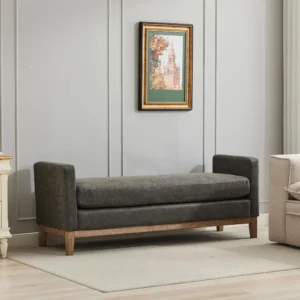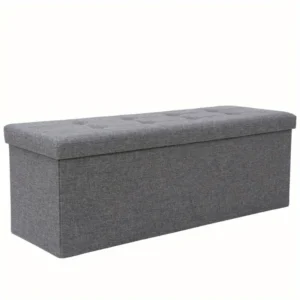Why Proper Shoe Organization in Entryways Matters
Walking into a home where shoes are scattered across the entryway creates an immediate impression of chaos. This common household challenge affects not just the appearance of your home but also its functionality and cleanliness. Entryway shoe clutter presents several problems:
- Creates tripping hazards for family members and guests
- Allows dirt and debris to be tracked throughout your home
- Produces visual disorder that can increase stress levels
- Makes finding the right pair of shoes during busy mornings frustrating
The average American household owns approximately 19 pairs of shoes per person, which translates to significant storage needs for a family of four. Proper organization can save up to 10 minutes during hectic morning routines – time better spent enjoying breakfast or avoiding traffic.
An entryway bench with integrated shoe storage offers the perfect dual-purpose solution. These practical pieces provide a comfortable seat for putting on and removing shoes while simultaneously creating dedicated space for organized footwear. When shoes have a designated home, your entryway transforms from a chaotic drop zone to a welcoming introduction to your living space.
The relationship between organization and functionality becomes especially important in smaller homes where every square inch matters. Thoughtfully designed entryway furniture with shoe compartments can dramatically improve both the appearance and function of your home’s entrance.
Understanding Your Needs: Before Choosing a Solution
Before investing in any storage solution, take time to assess your specific situation. Consider these key questions:
How many family members share your home? Each person typically needs space for at least 3-4 pairs of regularly worn shoes in the entryway.
What is your total available space? Measure your entryway carefully, accounting for door swing clearance (typically 30-36 inches) and maintaining at least 36 inches of walking path.
What types of shoes do you need to store? Athletic shoes, work boots, children’s sneakers, and seasonal footwear all require different storage considerations.
What’s your aesthetic preference? Storage solutions should complement your home’s style rather than detract from it.
A simple formula for calculating your basic entryway shoe storage needs:
(Number of household members) × (3-4 pairs of everyday shoes) = Minimum storage capacity needed
Creating distinct “zones” in your entryway helps maintain organization. Consider designating areas for:
– Everyday shoes in easy-to-access locations
– Seasonal footwear in adjustable spaces
– Guest shoes in a separate, clearly identified area
Understanding these requirements will help you make informed decisions when choosing the perfect bench for shoe storage that matches both your functional needs and design preferences.
Types of Entryway Benches with Built-in Shoe Storage
When selecting a bench with built-in shoe storage, several designs offer different advantages depending on your needs, space constraints, and aesthetic preferences.
Cubby Benches
These benches feature individual compartments designed specifically for shoes. The divided spaces keep pairs separated and organized, preventing the “shoe pile” effect. Cubbies typically accommodate 6-12 pairs depending on size and configuration. They work exceptionally well for households where each family member needs their own designated space.
Open Shelf Benches
Featuring one or more horizontal shelves beneath the seating surface, these benches offer flexible storage. They’re ideal for different shoe sizes and can be adapted with baskets or dividers. The open design promotes better air circulation, reducing odors and moisture buildup. However, without dividers, shoes may become disorganized more easily.
Lift-Top Storage Benches
These versatile pieces feature a hinged seat that opens to reveal storage space inside. While not always designed specifically for shoes, they offer concealed storage for seasonal or less frequently worn footwear. The hidden storage keeps visual clutter at bay but may limit air circulation.
Bench Cabinets with Doors
Combining seating with enclosed cabinet storage, these units conceal shoes completely behind doors. They present a clean, finished appearance suitable for more formal entryways. The enclosed design helps contain dirt and debris but may restrict airflow and accessibility.
| Bench Type | Pros | Cons | Ideal For | Price Range |
|---|---|---|---|---|
| Cubby Bench | Organized, designated spaces | Fixed compartment size | Families needing assigned spaces | $150-300 |
| Open Shelf | Good airflow, flexible space | Can look messy if overfilled | Varied shoe sizes, casual homes | $100-250 |
| Lift-Top | Hidden storage, clean look | Limited ventilation | Less frequently used shoes | $120-350 |
| Cabinet Style | Conceals clutter, polished appearance | Restricted airflow, less accessible | Formal entryways, minimalist designs | $200-500 |
Materials significantly impact both appearance and durability. Solid wood offers classic appeal and longevity but comes at a higher price point. Engineered wood provides budget-friendly alternatives while maintaining attractive finishes. Metal components add industrial style and strength to high-traffic areas.
For homes with multiple residents, the ultimate guide to shoe storage benches offers additional insights on selecting the right capacity and configuration for your household’s specific needs.
Various high-quality entryway bench storage options provide integrated solutions that balance seating needs with effective shoe organization, creating a cohesive entryway experience.
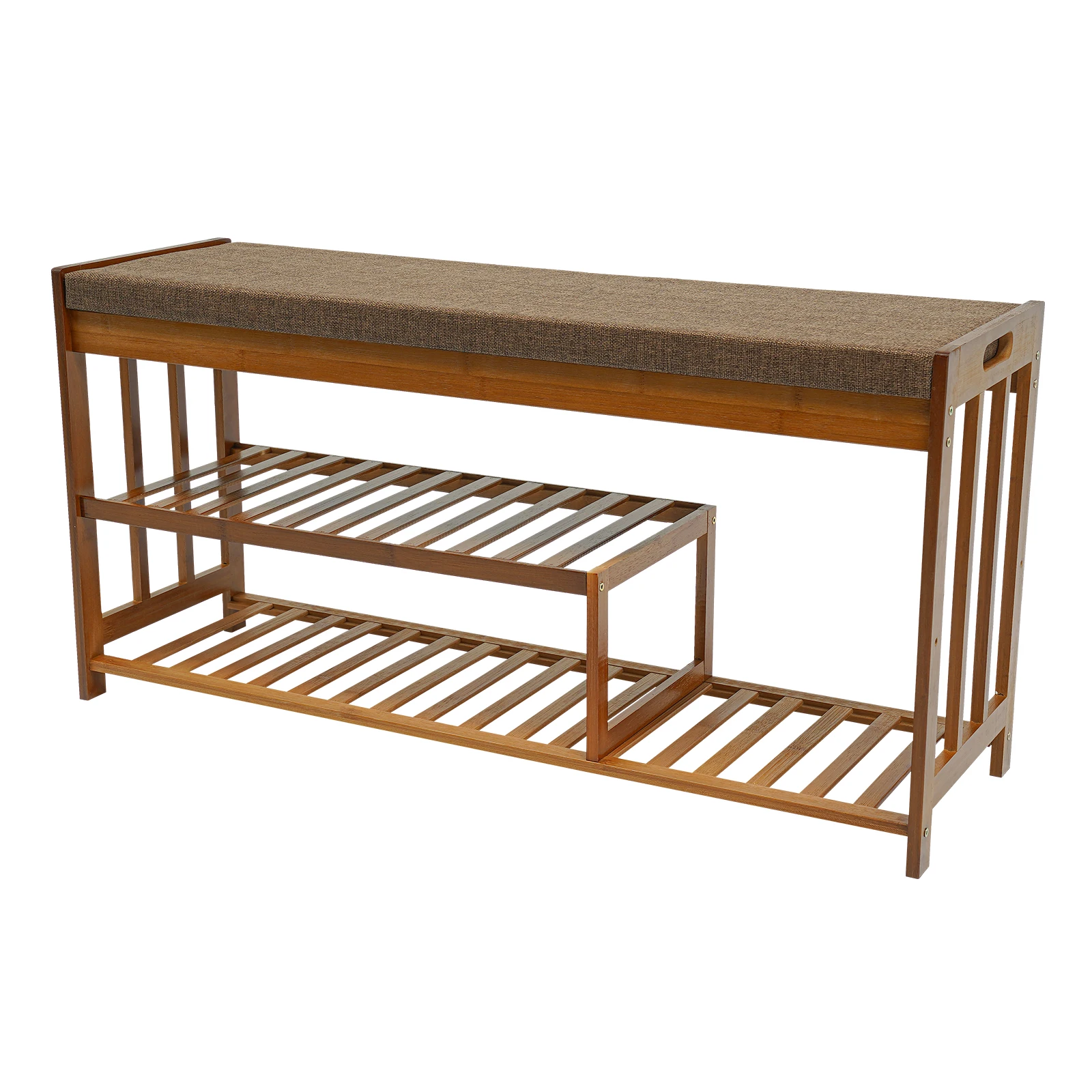
Maximizing Standard Benches for Shoe Storage
If you already own a standard bench without built-in storage or prefer the flexibility of a modular approach, numerous solutions can transform a simple bench into an efficient shoe organization center.
Under-Bench Storage Solutions
Baskets and Bins
– Fabric bins provide soft, flexible storage ideal for lightweight shoes and children’s footwear
– Wire baskets offer improved ventilation perfect for athletic shoes
– Plastic containers protect against moisture from wet shoes
– Woven baskets add natural texture and warmth to your entryway design
Shoe Trays and Boot Mats
– Water-resistant trays contain moisture and dirt from wet or muddy footwear
– Look for trays with raised edges at least 1-inch high to contain debris
– Materials like plastic, rubber, or metal provide easy cleaning and durability
– Place directly under benches for snow boots and rain shoes
Rolling Storage
– Wheeled shoe racks or carts slide easily for access to footwear stored deeper under benches
– Low-profile drawers designed to fit under furniture maximize use of under-bench clearance
– Look for options with handles for easy access
– Ensure casters lock to prevent unwanted movement
Stackable Organizers
– Modular shoe racks that can be configured horizontally or vertically
– Adjustable units accommodate different shoe heights and sizes
– Look for options with at least 4-5 inches of clearance per tier for standard shoes
When selecting containers for under-bench storage, measure carefully. You’ll need:
– Height clearance: Minimum 6-8 inches for low containers, 10-12 inches for taller options
– Width: Typically 12-16 inches for standard shoe storage
– Depth: Usually 12-14 inches to accommodate adult shoe sizes while fitting under standard benches
For proper ventilation, choose containers with openings, mesh components, or slats. This prevents odor buildup and allows damp shoes to dry properly. Organizing shoes by frequency of use makes the system more functional—place everyday shoes in the most accessible containers, with seasonal or occasional footwear in less convenient positions.
Entryway benches with shelf storage offer ready-made solutions with appropriate dimensions and clearances already designed for optimal shoe organization.
Specialized Storage Solutions for Different Shoe Types
Different footwear styles present unique storage challenges. By tailoring your approach to specific shoe types, you’ll create a more functional and organized entryway.
Everyday Casual Shoes
- Store on open shelves or in cubbies for quick access
- Arrange pairs side-by-side rather than stacked
- Allow 8-10 inches of width per pair
- Use shoe stacker dividers to maximize shelf space
- Tips: Place frequently worn shoes at eye level or in the most accessible locations
Boots
- Tall boots (knee-high): Use boot shapers or rolled magazine inserts to maintain shape
- Mid-calf boots: Store on their sides or with shaft folded down if space is limited
- Ankle boots: Treat similar to shoes, but allow additional height in storage compartments
- Tips: Store tall boots on the floor under benches rather than on shelves; use boot trays under wet winter boots to protect flooring
Seasonal Footwear
- Dedicate less accessible storage space to off-season shoes
- Use clear containers with labels for items stored for months at a time
- Implement a seasonal rotation schedule (store winter boots in summer months)
- Tips: Clean thoroughly before storing long-term; stuff with tissue paper to maintain shape
Children’s Shoes
- Use lower cubbies or bins for kid-height accessibility
- Implement color-coding or labeling for younger children
- Allow growth room when planning storage capacity
- Consider extra space for muddy play shoes or sports cleats
- Tips: Designate a specific “muddy shoe zone” with washable containers
Formal Shoes
- Store in protected areas away from heavy traffic
- Consider dust bags for expensive or delicate materials
- Use shoe trees for leather shoes to maintain shape
- Tips: Keep formal shoes on higher shelves or inside bench storage to protect from damage
For efficient seasonal rotation, implement a twice-yearly system (spring/fall) to evaluate which shoes need accessible storage and which can be stored elsewhere. Primary entryway storage should focus on current-season footwear with limited space for specialty items.
Homes with extensive outdoor activities or multiple children may benefit from specialized mudroom benches with shoe storage designed to handle greater volumes and varieties of footwear.
Strategic Organization Methods for Long-Term Success
Establishing systematic organization methods ensures your shoe storage solution remains effective long after the initial setup. Consider these proven approaches:
1. Family Zone System
Assign dedicated areas within your entryway storage for each household member. This creates clear ownership and accountability, reducing the “whose shoes are these?” dilemma. Label cubbies, bins, or shelf sections with names or use color-coding for younger children who can’t yet read.
2. Seasonal Rotation Schedule
Implement a twice-yearly rotation of footwear (typically spring and fall):
– Remove out-of-season shoes from prime entryway storage
– Clean thoroughly before storing elsewhere
– Evaluate condition and donate unused items
– Bring current-season footwear into the entryway area
3. Frequency-Based Arrangement
Position shoes based on how often they’re worn:
– Daily shoes: Most accessible positions
– Weekly wear: Secondary positions
– Occasional use: Less convenient storage areas
4. Visual Organization Systems
Arrange by visual characteristics to create order:
– Group similar styles together (athletic shoes, dress shoes, boots)
– Arrange by color families for an aesthetically pleasing look
– Store pairs together consistently (side by side or one in front of the other)
The key to long-term organization success is establishing clear systems that all household members understand and can maintain. For homes with children, create simple routines with visual cues that make proper shoe storage part of everyday habits.
Implement a “one in, one out” policy to maintain manageable quantities. When purchasing new everyday shoes, identify a pair for donation or seasonal storage to prevent overflow.
Schedule regular maintenance sessions (monthly works well for most households) to reset organization, clean storage areas, and address any developing problem areas before they become overwhelming.
Successfully organizing busy entryways requires consistency and simple systems that work with—rather than against—your family’s natural behaviors and habits.
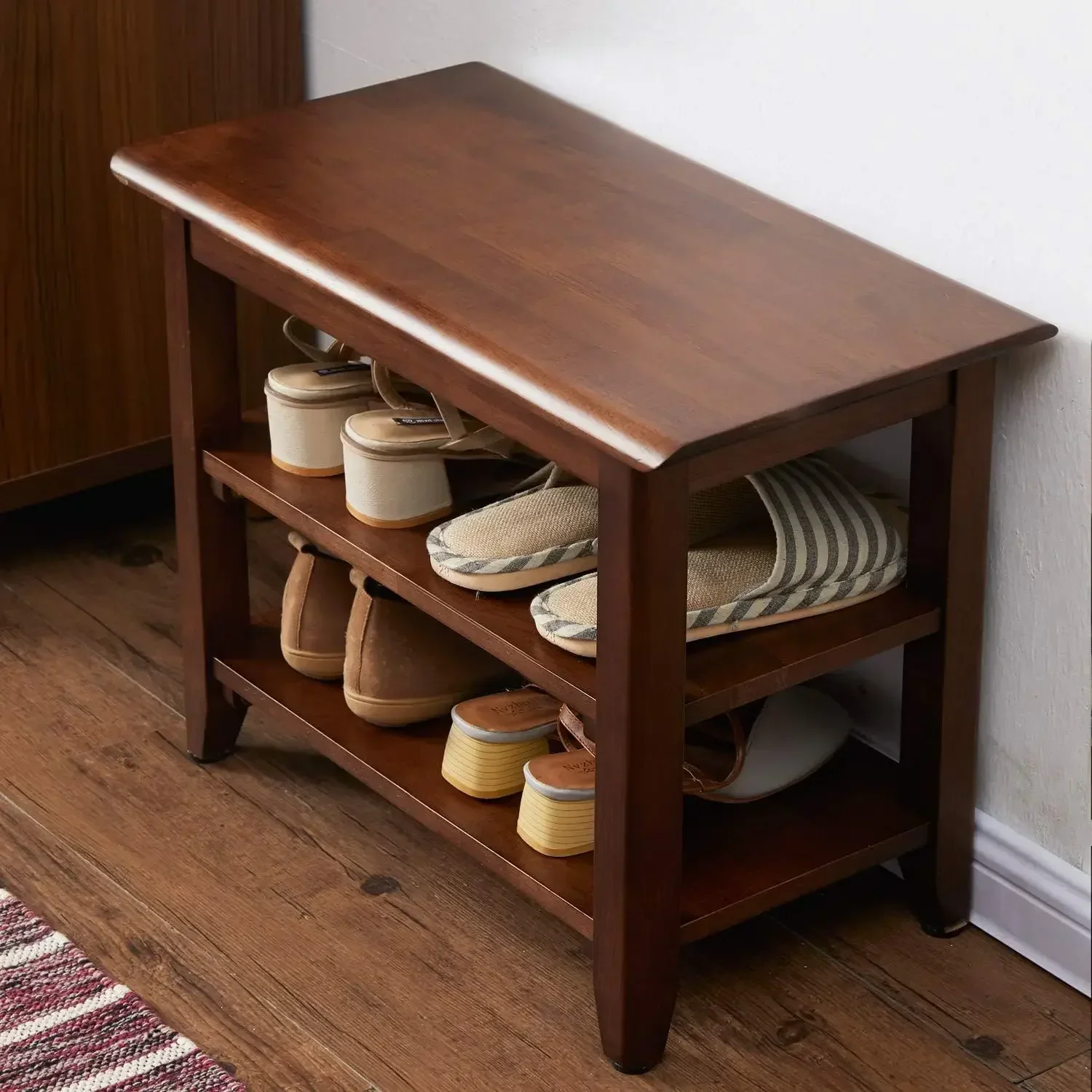
Design and Aesthetic Considerations
A functional shoe organization system doesn’t have to sacrifice style. Your entryway creates the first impression of your home, making aesthetic considerations just as important as practical ones.
Material Coordination
Choose storage elements that complement your existing décor:
– Wood tones: Match or intentionally contrast with flooring and trim
– Metal finishes: Coordinate with door hardware and light fixtures
– Fabric containers: Select colors that complement your wall color or accent pieces
– Natural materials like seagrass or rattan add warmth to contemporary spaces
Color Strategy
Use color to enhance your entryway’s appearance:
– Neutral-toned storage pieces blend seamlessly in smaller spaces
– Bold colors can create focal points in larger entryways
– Consistent color palette (varying shades of one color) creates a cohesive look
– Contrasting colors help define zones in multi-functional entryways
Visual Balance
Create pleasing proportions in your entryway design:
– Balance open and closed storage for visual interest
– Mix container types (baskets, bins, trays) for textural variety
– Incorporate decorative elements alongside functional pieces
– Consider the visual weight of pieces—heavier items lower, lighter pieces higher
Concealment vs. Display
Not all shoes deserve to be displayed:
– Use closed storage for work or athletic shoes
– Reserve open display for visually appealing footwear
– Incorporate decorative bins for necessary but less attractive items
– Consider frosted or textured cabinet fronts that hide contents while maintaining light flow
Adding Personal Touches
Incorporate decorative elements to elevate the space:
– Small plants add life and color (consider low-maintenance varieties like pothos or snake plants)
– Wall art above bench areas draws the eye up, creating height
– Decorative hooks or hardware upgrade utilitarian elements
– A mirror serves dual purpose—functionality and the illusion of more space
Quality entry shoe storage furniture solutions balance practical needs with design elements that enhance your home’s appearance rather than detract from it.
Entryway Bench with Cushion, Mudroom Bench with Cushion, Shoe Bench for Entryway
$1,186.63 Select options This product has multiple variants. The options may be chosen on the product pageCoat Rack Shoe Bench, Corner Entryway Bench, Corner Hall Tree, Shoe Bench for Entryway
$313.58 Select options This product has multiple variants. The options may be chosen on the product pageEntryway Bench with Back, Modern Entryway Bench, Shoe Bench for Entryway
Price range: $463.13 through $474.44 Select options This product has multiple variants. The options may be chosen on the product pageShoe Storage Bench for Entryway
$459.02 Select options This product has multiple variants. The options may be chosen on the product pageEntryway Bench with Shelf Storage, Shoe Bench for Entryway, Shoe Storage Bench
$194.08 Select options This product has multiple variants. The options may be chosen on the product pageCorner Entryway Bench, Entryway Bench with Cushion, Modern Entryway Bench, Shoe Bench for Entryway
$476.34 Select options This product has multiple variants. The options may be chosen on the product page
DIY Shoe Storage Solutions for Entryway Benches
Creating custom shoe storage solutions allows you to perfectly match your specific space requirements while staying within budget. These accessible DIY projects can transform a basic bench into an efficient organization system.
Simple Under-Bench Shelf
Materials:
– 3/4” plywood or MDF board (cut to bench width minus 1” × bench depth minus 1”)
– 4 L-brackets with screws
– Wood finish (paint, stain, or polyurethane)
– Basic tools: drill, screwdriver, sandpaper, measuring tape
Steps:
1. Measure the space under your bench, allowing 1/2” clearance on all sides
2. Cut board to size or have it cut at your local hardware store
3. Sand edges and surfaces until smooth
4. Apply chosen finish and allow to dry completely
5. Attach L-brackets to underside of bench, positioned to support shelf
6. Secure shelf to brackets with screws
7. Allow 4-6 inches clearance from floor for easy cleaning
Cost estimate: $20-35 depending on materials
Custom Shoe Dividers
Materials:
– 1/4” plywood (approximately 8” × 12” pieces)
– Wood glue
– Small nails or brad nailer
– Sandpaper
– Paint or finish
Steps:
1. Measure space between existing shelves
2. Cut divider pieces to fit height and depth
3. Sand all edges smooth
4. Apply finish as desired
5. Attach dividers perpendicular to shelves using wood glue and small nails
6. Space dividers 3-4” apart for children’s shoes, 4-6” for adult shoes
7. Allow glue to dry completely before using
Cost estimate: $15-25
Repurposed Container Organization
Materials:
– Wine crates, plastic milk crates, or sturdy cardboard boxes
– Fabric (optional)
– Staple gun or fabric glue
– Paint or decorative paper (optional)
Steps:
1. Select containers that fit under your bench
2. Clean thoroughly and repair if necessary
3. For aesthetic improvement, cover with fabric or paint
4. Arrange under bench in configuration that maximizes space
5. Consider adding casters to bottom of containers for easy access
Cost estimate: $0-20 depending on materials
Safety Considerations
- Ensure all edges are smooth and splinter-free
- Verify weight capacity of any hanging or bracketed solutions
- Use appropriate wall anchors for wall-mounted components
- Apply non-slip pads to bottom of free-standing elements
- Keep children’s access in mind when selecting hardware
These DIY projects can be customized to match dimensions and aesthetics of your specific space. Draw inspiration from shoe rack benches to incorporate successful design elements into your own creation.
Handling Special Challenges: Wet, Muddy, and Smelly Shoes
Entryway shoe storage must address the practical challenges that come with footwear, particularly in regions with diverse weather conditions.
Managing Wet Shoes
Wet shoes present both immediate mess concerns and potential long-term damage to your storage solutions and flooring.
Solutions:
– Install a dedicated boot tray with raised edges (at least 1” high)
– Use water-resistant materials like plastic, rubber, or treated metal for shoe storage areas
– Place absorbent mats beneath storage to catch drips
– Consider shoe dryers for extremely wet conditions
– Position hooks near benches for hanging soaked shoes to dry before storage
Prevention Tips:
– Apply waterproofing treatments to fabric and leather shoes seasonally
– Place a covered outdoor storage area for transitioning extremely wet footwear
– Use removable and washable liners in storage containers
Conquering Mud and Debris
Soil, sand, and other debris create cleaning challenges and can damage floors and furniture.
Solutions:
– Position a coarse outdoor mat for initial debris removal
– Add a second, finer indoor mat to catch remaining particles
– Install shoe cleaning stations (brushes, scrapers) outside main entrances
– Use open mesh containers that allow dirt to fall through rather than accumulate
– Implement designated “dirty shoe zones” with easy-clean surfaces
Maintenance Routine:
– Empty and clean trays weekly during muddy seasons
– Vacuum or sweep storage areas twice weekly
– Wipe down bench surfaces regularly to prevent grit damage
Combating Odors
Shoe odors can quickly permeate enclosed spaces like entryways.
Solutions:
– Prioritize ventilated storage designs with air circulation
– Place activated charcoal pouches or cedar blocks in storage areas
– Use baking soda-filled sachets in or near shoe storage
– Install small fans in enclosed storage spaces if persistent odors occur
– Separate athletic shoes from regular footwear when possible
Prevention Steps:
– Allow shoes to dry completely before storage
– Use moisture-wicking insoles in frequently worn shoes
– Rotate shoes to allow 24-hour “rest periods” between wearings
– Clean shoe interiors regularly with appropriate products
For homes in climates with extreme weather conditions, practical bench organization solutions that address these challenges ensure your entryway remains functional and appealing year-round.
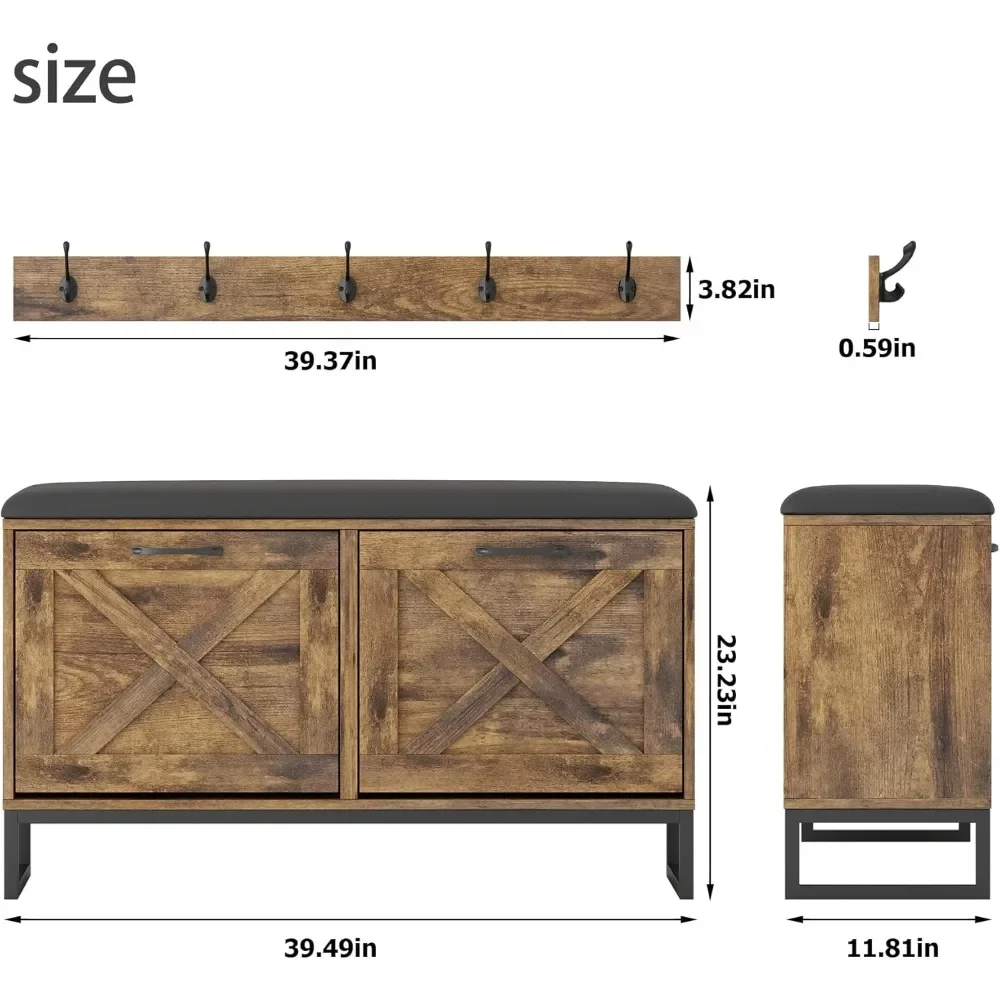
Maintenance and Seasonal Refresh Systems
Maintaining your shoe organization system ensures it continues functioning effectively long after initial setup. Implementing regular maintenance routines keeps your entryway inviting and functional.
Weekly Maintenance
Quick regular attention prevents larger organizational breakdowns:
– Return misplaced shoes to their proper locations
– Wipe down bench surfaces and storage containers
– Sweep or vacuum around and under storage areas
– Empty and clean any debris trays
– Check and replace odor absorbers as needed
Monthly Deep Clean
More thorough attention maintains both appearance and function:
– Remove all shoes from storage temporarily
– Clean storage surfaces thoroughly with appropriate cleaners
– Check for moisture damage or wear
– Rearrange shoes based on seasonal needs
– Assess if any containers need replacement
– Evaluate if the current system is still meeting family needs
Seasonal Transition Checklist
Spring Transition (March/April)
- Remove and clean winter boots and heavy footwear
- Store clean winter items in less accessible locations
- Deep clean all storage areas, especially salt and mud residue
- Bring forward spring footwear
- Assess if any winter shoes need repair before storage
Fall Transition (September/October)
- Rotate summer shoes to secondary storage
- Clean sandals and summer shoes before storing
- Bring forward boots and closed-toe shoes
- Check waterproofing on winter footwear
- Assess if additional winter storage is needed
Family Involvement Strategies
The most effective systems engage all household members:
– Create simple visual guides showing where things belong
– Implement reward systems for younger children maintaining organization
– Hold brief weekly “reset” sessions where everyone participates
– Assign specific areas to each family member for maintenance
– Make seasonal transitions a family activity with clear roles
Regular evaluation allows for system refinement. If certain aspects aren’t working—shoes consistently end up in the wrong place or storage seems inadequate—be willing to adjust your approach rather than fight against natural behaviors.
These maintenance principles apply equally to large homes and small apartment organization with benches, though scale and frequency may vary based on household size and entryway dimensions.
Troubleshooting Common Shoe Organization Problems
Even well-designed organization systems encounter challenges. Here are solutions to the most common shoe storage dilemmas:
“We have too many shoes for our bench storage”
Solution: Implement a rotation system where only current-season shoes occupy prime entryway storage. Store off-season footwear elsewhere (under beds, in closets, or in dedicated storage containers). For households with extensive shoe collections, consider:
– Creating a “one in, one out” policy
– Establishing a secondary shoe storage location beyond the entryway
– Using vertical space with stacking organizers
– Installing wall-mounted shoe storage to supplement bench space
“Family members won’t maintain the organization system”
Solution: Simplify your system to match natural behaviors rather than fighting against them. Create obvious visual cues showing where items belong and make proper storage more convenient than improper storage:
– Label storage spaces clearly with names or pictures
– Position bins directly where shoes tend to be dropped
– Reduce steps required to put shoes away properly
– Create playful elements like “basketball” bins for children
– Hold weekly five-minute family reset sessions
“Our entryway is too small for a bench with storage”
Solution: Consider space-saving alternatives that maintain functionality:
– Wall-mounted shoe racks with a small stool for seating
– Narrow profile storage cabinets (12” deep or less)
– Over-door hanging organizers on nearby closets
– Dual-purpose furniture like storage ottomans
– Corner bench designs that maximize awkward spaces
Small shoe benches specifically designed for compact entryways offer streamlined solutions for limited spaces.
“The bench storage doesn’t fit our boots”
Solution: Create dedicated boot storage solutions:
– Use vertical boot organizers that hold boots upside down
– Install a separate boot tray beside the bench
– Replace fixed dividers with adjustable or removable ones
– Add boot shapers to help tall boots stand upright
– Utilize the space under the bench without dividers for tall items
“Our shoe storage always looks cluttered despite organization”
Solution: Focus on visual containment and consistency:
– Use matching containers to create visual cohesion
– Implement closed storage for visually chaotic items
– Establish a maximum capacity and stick to it
– Create “display worthy” and “hidden storage” categories
– Add decorative elements that draw attention away from necessary clutter
Modern Innovations in Entryway Shoe Storage
The world of entryway organization continues to evolve with innovative solutions addressing common challenges. These modern approaches combine aesthetics, functionality, and technology to enhance traditional storage methods.
Smart Storage Solutions
Technology integration is transforming shoe storage functionality:
– UV sanitizing compartments reduce odor and bacteria
– Built-in dehumidifiers prevent moisture damage in humid climates
– Motion-sensor lighting illuminates storage areas automatically
– Climate-controlled cabinets protect valuable footwear
– Heated boot dryers integrated into storage units for winter footwear
Space-Optimizing Designs
Urban living demands creative space utilization:
– Hydraulic lift benches reveal storage compartments while maintaining clean lines
– Wall-mounted folding benches that collapse when not in use
– Rotating shoe cabinets that maximize corner spaces
– Modular systems that expand or contract based on seasonal needs
– Multi-tiered designs that utilize vertical space efficiently
Sustainable Materials and Approaches
Eco-conscious storage solutions reflect growing environmental awareness:
– Bamboo and responsibly harvested wood alternatives
– Recycled plastic components with extended lifespans
– Biodegradable organization containers
– Multifunctional designs reducing the need for multiple furniture pieces
– Naturally anti-microbial materials reducing chemical treatments
Adaptable Systems
Flexibility accommodates changing household needs:
– Adjustable dividers that reconfigure as shoe sizes change
– Removable components for cleaning or rearrangement
– Expandable systems that grow with your collection
– Interchangeable parts allowing seasonal customization
– Height-adjustable shelving for varying footwear types
When evaluating these premium features, consider your specific household challenges. A family in a rainy climate might benefit significantly from integrated drying features, while a compact urban apartment might prioritize space-saving innovation.
For contemporary aesthetics combined with practical storage, modern entryway benches showcase current design trends that balance form and function.
Additional Organization Elements that Complement Shoe Storage
Creating a complete entryway organization system extends beyond shoe storage. Complementary elements work alongside your bench to create a functional, cohesive entry zone.
Wall-Mounted Solutions
Vertical space utilization keeps surfaces clear while providing essential storage:
– Hook systems positioned 12-15 inches above bench height for coats and bags
– Wall pockets or mail organizers to prevent bench-top clutter
– Key hooks placed at adult eye level (approximately 60-65 inches from floor)
– Small shelves for seasonal items like sunglasses or winter accessories
– Magnetic strips for securing metal items like keys or children’s school badges
Umbrella Storage
Proper umbrella storage prevents water damage to floors and furniture:
– Dedicated umbrella stands with drip trays
– Side-mounted umbrella hooks on benches
– Built-in drainage systems in entryway furniture
– Slim umbrella holders that fit between other storage pieces
– Wall-mounted umbrella racks that save floor space
Small Item Management
Entryways collect small but essential items that need organized homes:
– Designated containers for gloves, hats, and scarves
– Small drawers or bins for sunglasses and reading glasses
– Charging stations for phones and electronic devices
– Change and key dishes to prevent pocket items from scattering
– Dedicated spots for dog leashes and pet accessories
Creating Logical Flow
The arrangement of these elements should follow your household’s natural patterns:
– Position key storage near the door for easy grab-and-go access
– Keep children’s items at lower heights for independence
– Place most frequently used items in prime accessibility zones
– Group related items together (outdoor accessories, school items)
– Create clear pathways that accommodate multiple people during busy times
When planning a complete entryway system, allow approximately 24 inches of bench space per family member, with corresponding storage proportions. For additional vertical storage combined with seating and shoe organization, entryway hall trees offer integrated solutions that address multiple storage needs in a cohesive unit.
By thoughtfully combining shoe storage with these complementary elements, your entryway becomes not just organized but truly functional—a space that supports your household’s coming and going with minimal friction and maximum efficiency.


